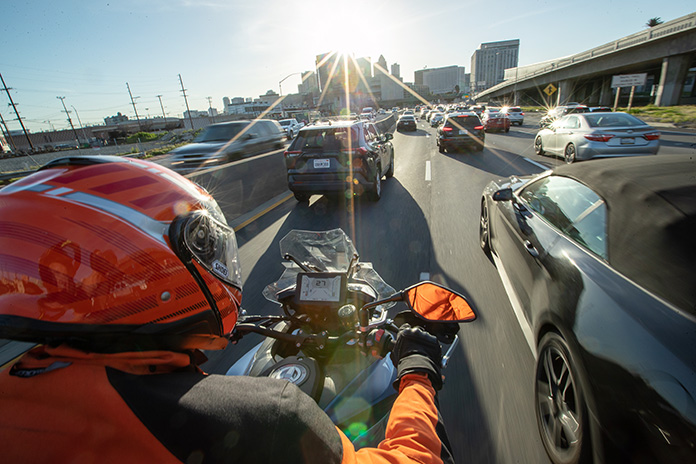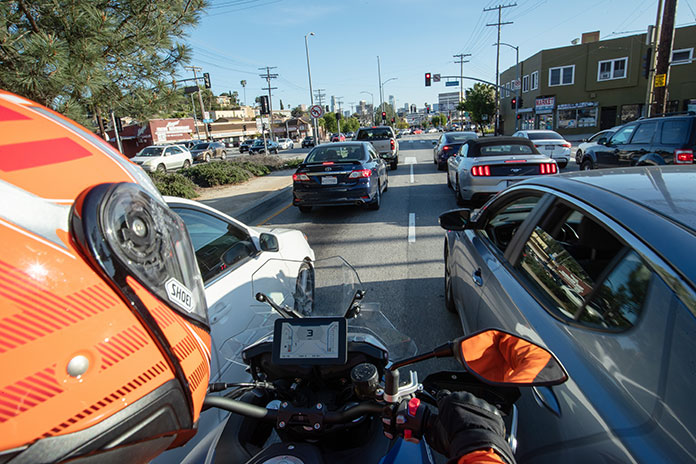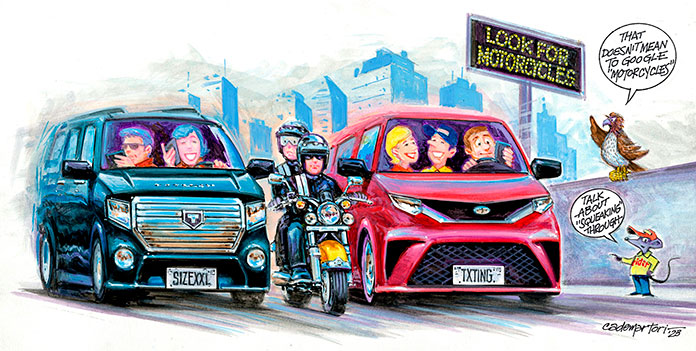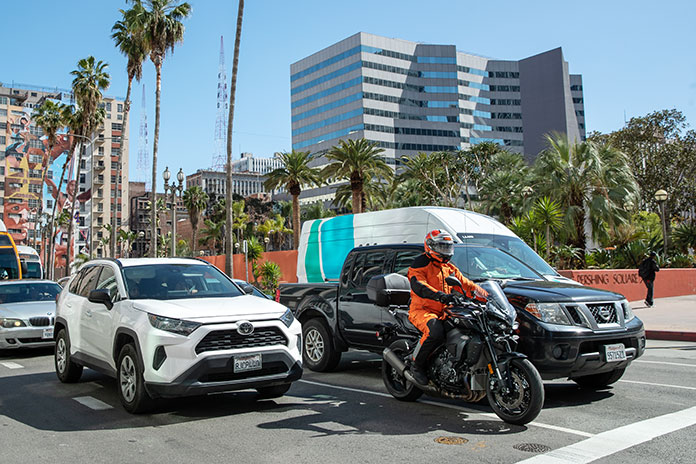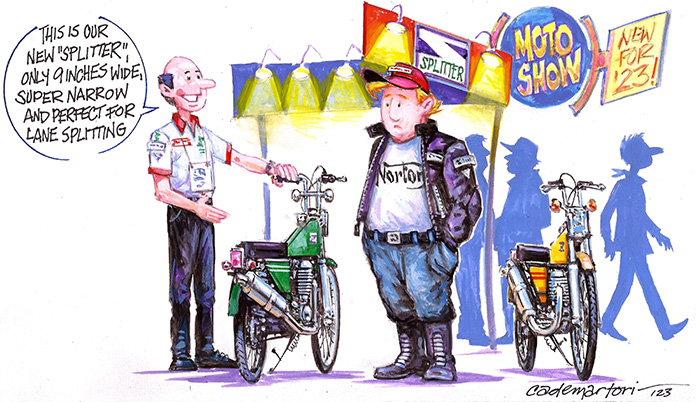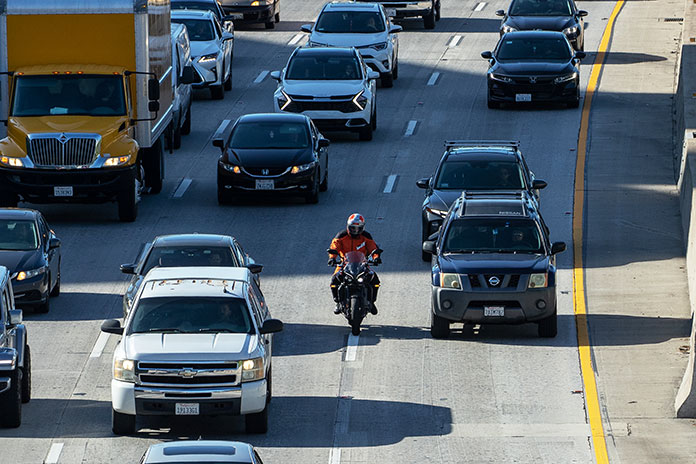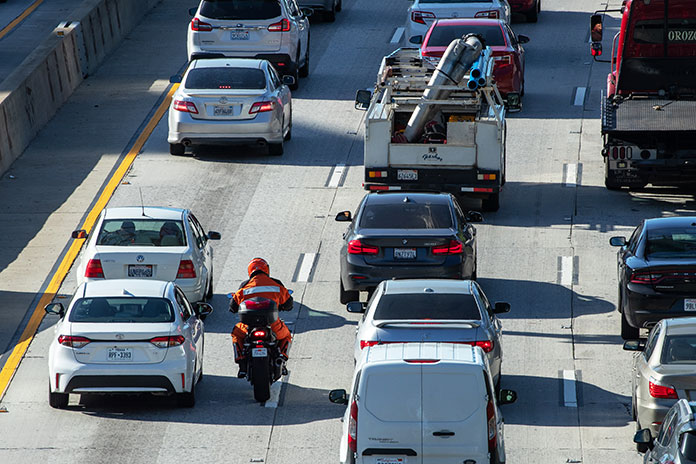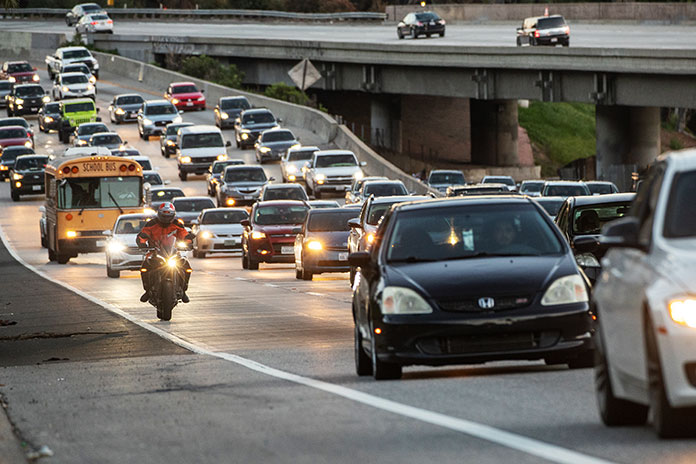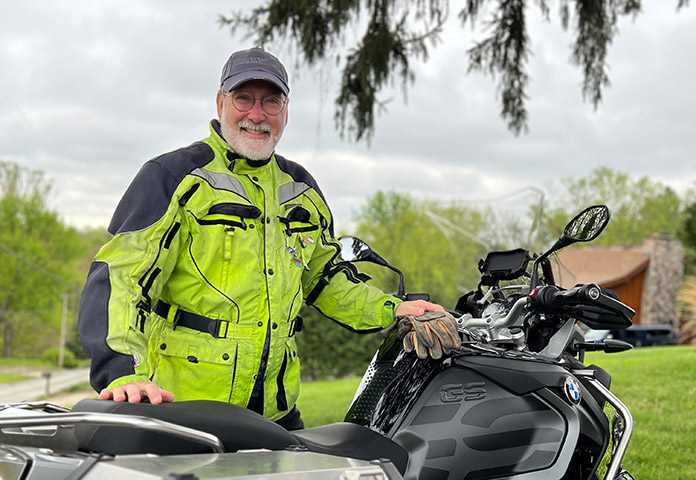As part of the Stayin’ Safe advanced rider training program – a method that leads a small group of experienced motorcyclists on road tours and delivers real-time, real-world coaching via in-helmet communications – I’m often asked by participants to address specific aspects of road riding unique to the region where a training tour is being conducted. As part of our Southern California training tours, I’ve been routinely asked if I would be teaching techniques for safe lane splitting.
Although it is intriguing to consider, I always decline. While I agree it would be a valuable teaching opportunity for that riding environment, I also realize it would be impractical with a group of riders since traffic dynamics change rapidly – as would recommended tactics depending on the bike and the circumstances. But perhaps the bigger challenge would be to get consensus among the riders to do it in the first place. Even if all participants are from California (and they rarely are), there are always distinct and deeply polarized views about lane splitting. Riders are adamantly for it or against it.
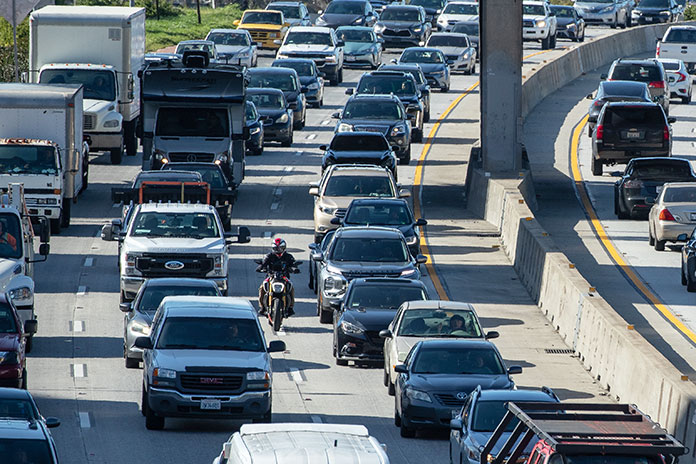
The term “lane splitting” gets tossed around outside of California more often these days as several other states – including Utah, Montana, Arizona, and Hawaii – have legalized some form of the practice, while others are considering it. As lane splitting becomes more widespread, the volume of polarized opinions is expanding as well.
But maybe I’m getting ahead of myself. Let’s start by defining what lane splitting is. For starters, it’s not a universal term. “Splitting” is one type of lane sharing motorcyclists have been doing for years on California freeways, but there are other forms (and terms) we should know.
Related: On Lane Splitting with Eric Trow | Ep. 60 Rider Magazine Insider Podcast
What is Lane Sharing?

In the broadest sense, lane sharing, lane splitting, lane filtering, white lining, and a handful of other terms are used to describe the act of advancing a motorcycle through slow or stopped traffic on a multilane road (all heading the same direction, of course) by riding between lanes at a slightly higher speed than the flow of other vehicles. That’s it, in a congested traffic nutshell.
Are We Lane Splitting or Lane Filtering?
While “lane splitting” is a term used broadly to describe riding between lanes of traffic, there are distinctions between lane splitting and lane filtering.
When riding on a multilane highway such as a limited-access freeway, a motorcyclist might “split” the lanes and ride between two lines of vehicles if the traffic has slowed or come to a stop due to congestion. That’s what’s specifically referred to as lane splitting.
When riding in multiple lanes of traffic where there are intersections and traffic signals, a rider might move forward or “filter” between rows of vehicles stopped at a light, enabling the rider to move to the front of the line. This is lane filtering.
Why Do It?
The primary argument for lane splitting and lane filtering is that they are deemed safer practices that reduce opportunities for motorcyclists to be rear-ended in high-volume, stop-and-go traffic. Frankly, that’s a pretty strong argument since busy roadways are a high-risk environment for motorcyclists – perhaps even more so as increasingly distracted drivers are putting riders at higher risk.
Lane splitting is also claimed to give riders a better view through traffic as well as improved mobility. It’s contended that it allows riders to see farther ahead, actively separate themselves from threats, and strategically place their bikes in pockets of less congestion.
Lane splitting has been touted as helping to reduce fuel consumption and emissions by minimizing the time motorcycles sit in slow or stopped traffic. It also helps reduce traffic congestion because there are fewer vehicles sitting single-file in traffic lanes.
Does Lane Splitting Reduce Risk?
Yes and no. Motorcycle Lane-splitting and Safety in California, a 2015 study conducted by the Safe Transportation Research & Education Center at the University of California Berkeley, took a good long look into the matter to “increase our understanding of collisions involving lane-splitting motorcyclists and of how lane splitting impacts collision injuries.”
The study found that lane splitting appears to reduce certain types of crashes, specifically rear-end collisions. That’s great news. Lane-splitting riders were less than half as likely to be rear-ended than their non-lane-splitting brethren (2.6% vs. 4.6%). Those figures would look even better if some of those riders involved in a collision hadn’t been rear-ended by fellow riders who were following too closely (thanks, bud).
With fewer rear-end collisions, the analysis also showed that lane-splitting motorcyclists involved in a collision were injured less frequently than non-lane-splitters. They were half as likely to suffer a head injury (9% vs. 17%) and about a third less likely to sustain a torso injury (19% vs. 29%). Although fatalities are rare, even those were reduced by more than half (1.2% vs. 3.0%). Again, good news.
But with the good comes the bad (doesn’t it always?).
Lane splitting doesn’t eliminate crashes. Lane-sharing riders just crash differently and not as badly (provided speed is kept to a minimum).
While lane splitting and lane filtering can help a rider escape certain significant threats, it does introduce new ones. For example, there’s a smaller safety bubble. You’ll recall learning in your Motorcycle Safety Foundation or Total Control training course (you took one of those, right?) how important it is to maintain a safety cushion around your motorcycle. Riding between lanes puts motorcyclists significantly closer to other vehicles than they would be otherwise. That can make the rider more vulnerable from both sides (but less so front and rear) since there is less space to maneuver left or right – and therefore less time to react – if a driver makes a sudden move.
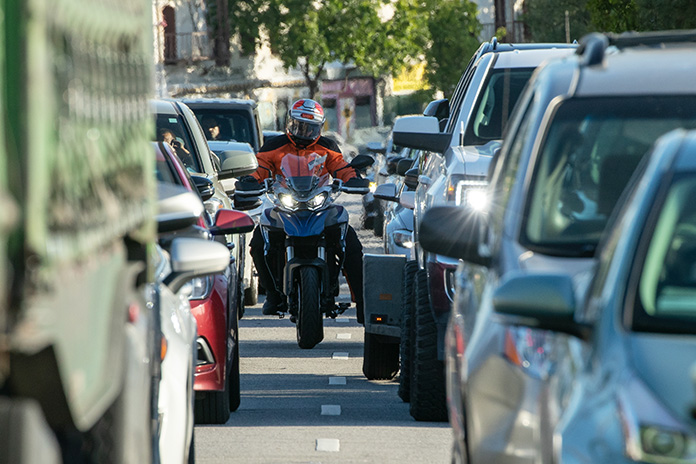
The highest risk for any motorcyclist lane splitting in freeway traffic is other vehicles changing lanes. In suburban and city environments, lane filtering riders can find themselves among vehicles unexpectedly maneuvering into or out of traffic.
As a result, while lane splitting may reduce the likelihood of the rider being rear-ended, they are more than twice as likely to rear-end other vehicles (38% of lane-splitting riders vs. 16% of non-lane-splitting riders). That one’s on us.
Beyond the known hazards of riding too fast (surely you’ve heard, “speed kills”), the risk and severity of injury grows when there is an increase in the speed of the motorcycle compared to the pace of surrounding traffic – what’s known as “speed differential.” That speed difference between bike and traffic can play a significant role in causing a collision while lane splitting or filtering.
Perhaps the Greatest Challenge of All…
For the rider who is weighing the pros and cons of lane sharing, a serious consideration should be the low public awareness of lane splitting and the attitudes of other drivers.
Another U.C. Berkeley study from 2014 probed the minds of California drivers and motorcyclists. Even in California, where lane splitting and filtering have been common practices for decades, roughly half of all California drivers either believed that lane splitting was illegal (it wasn’t) or they were unsure about its legality. Such perceptions can contribute to negative attitudes about the practice. That study revealed 61% of non-motorcyclists in the Golden State disapproved of lane splitting.
Do drivers believe lane splitters are unwilling to play by the same rules others must adhere to, or that they are just acting as renegades?
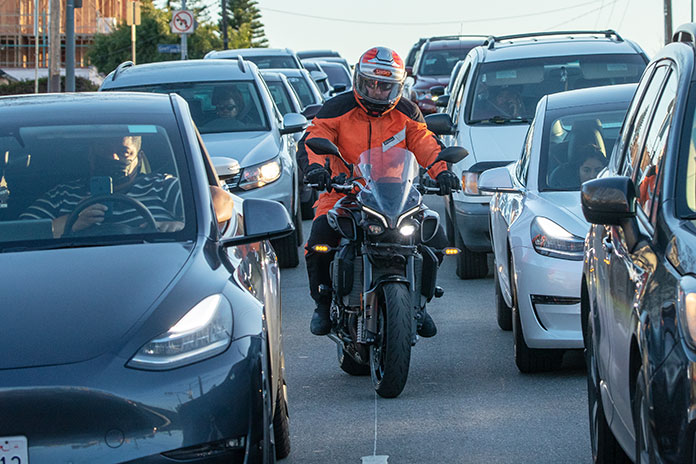
I became particularly curious about the behavior of drivers and the potential impact (figuratively and literally) on motorcyclists as they consider the practice of lane sharing, especially in states where the concept has recently been introduced.
When it comes to driver behavior, I believe there are few better go-to resources than Tom Vanderbilt’s fantastic, well-researched book, Traffic: Why We Drive the Way We Do (and What It Says About Us). The author addresses the physical, psychological, and sociological aspects of traffic and how drivers, as human beings, interact with each other. I reached out to Vanderbilt to get his take on the potential challenges associated with introducing a practice like lane sharing into the general traffic environment.
“I am well aware of a dynamic that I am sure affects motorcyclists a lot, which I’ll call an ‘empathy imbalance,’” he said, defining the term as the phenomenon whereby people who drive cars may be unable to relate to motorcyclists since most car drivers don’t ride motorcycles and are unfamiliar with – and therefore unable to empathize with – the two-wheeled mode of transportation.
“So often drivers simply don’t understand the motives or behavior of the other mode,” Vanderbilt continued, “and they often translate their own confusion to some failing on the part of the other user. What might seem like rational or safe behavior on the part of a motorcyclist may seem reckless or like ‘cheating’ to a driver, who simply sees some ‘other’ they don’t fully understand.”
Vanderbilt’s advice? “Don’t think that your view of what is ‘commonsense behavior’ is shared by everyone around you.” In other words, until the practice is more common and drivers see enough people doing it – to a point where it no longer seems like strange and rebellious behavior – we should assume that lane splitting will be out of the norm for other motorists and may be viewed as unacceptable traffic behavior.

The “empathy imbalance” is a compelling way to capture the mindset gap that exists out on the roadway and how that imbalance could be a chasm the size of the Grand Canyon in states where neither lane splitting nor lane filtering have ever been routine behavior. When it comes to lane sharing, especially where the practice is just being introduced, that empathy imbalance may be the greatest threat of all to motorcyclists.
Sidebar: What do Lane Splitters Look Like?
While some folks might expect lane splitters and filterers to be wild-haired outlaw rebels without causes, research paints a different picture. Contrary to the ruffian image, research reveals that lane splitters tend to be:
- Regular commuters riding during weekday commuting hours
- Wearing proper riding gear, including full-face helmets
- Riding solo and riding sober
- Splitting lanes only when traffic is at 30 mph or below
Can Lane Sharing Be Done Safely?
According to the U.C. Berkeley study, lane splitting and lane filtering appear to be relatively safe strategies and practices provided they are done in traffic traveling at 50 mph or less and motorcyclists stay within 15 mph of that traffic. Lower traffic speeds and a smaller speed differential between the bike and surrounding vehicles make it even safer.
The Motorcycle Industry Council (MIC), American Motorcyclist Association (AMA), National Highway Traffic Safety Administration (NHTSA), and Motorcycle Safety Foundation (MSF) all align in support of lane sharing as a safe strategy. The American Automobile Association (AAA), on the other hand, opposes the practice.

Beyond these authorities, I turned to another trusted source in California, my friend and fellow motorcycle proficiency expert Lee Parks. Among his many credentials, Parks owns and operates Total Control Training Inc. and authored the best-selling book Total Control: High Performance Street Riding Techniques. He also runs the rider training program for California and several other states. I asked Parks for his take on lane splitting.
“Having moved here in 1992, I can’t imagine living in another state that didn’t have lane splitting,” he said. “It’s safer, saves time, reduces the chances of getting rear-ended by other road users, and reduces the travel time for everyone by taking riders out of the long lines of traffic.” Parks shared how, for him, a two-hour commute by car became a manageable 45-minute ride by motorcycle.
Is lane splitting for everyone? Parks and I share the same opinion, but he articulates it better: “It’s good for any experienced rider who has excellent situational awareness. Lane splitting is not for the faint of heart, nor those new to riding. It requires an extreme amount of focus and attention to be safe, and all riding functions must already be in your muscle memory so they don’t take away from your awareness.
“I’d add that lane splitting is only safely manageable for someone who is not impaired in any way. This includes drinking, drugs, fatigue, or being mentally distracted.”
Safer Splitting and Friendlier Filtering
Whether you’re new to the practice or have been lane splitting or filtering for years, here are things you can do to improve your odds while improving your position in traffic.
First, stick to these two speed factors when lane sharing:
1. Traffic speed is slow or stopped. The faster traffic is moving, the greater the risk of incident and injury. Choose to filter past other vehicles only when traffic is moving below 50 mph, and the slower the safer.
2. Your speed is within 10-15 mph of traffic. A small speed differential is safer. By keeping your own speed close to that of traffic, you buy critical time and space to respond to emerging threats. Work the physics in your favor!
Apply these techniques each time you move between lanes:
- Look farther ahead, widen your view, and anticipate vehicles changing lanes.
- Be “tactical ready,” poised to smoothly slow down or maneuver as necessary.
- Stay to the left-most lanes on highways when lane splitting (between lanes #1 and #2).
- Don’t linger in blind spots.
- Beware of gaps that might invite other vehicles to change lanes just as you arrive.
- Avoid splitting lanes near entrance and exit ramps (it’s illegal in California).
- If riding with others, keep a safe distance between bikes to avoid rear-ending your buddy (or being rear-ended).
Of course, there is still the concern of other drivers and their response to lane-sharing motorcyclists, especially in states where the practice is not the norm. Until it is, riders should anticipate pushback from other motorists. Perhaps the best way to minimize that is to promote goodwill by being respectful, courteous, and empathetic to the other drivers who remain stuck in traffic (we’ve all been there).
Should You Do It?
It’s a personal choice – don’t ever let someone else force a lane-splitting decision for you. If you are still on the fence, here’s a little more filtering food for thought:
Not all motorcycles are created equal. While lane sharing is practiced by riders of all types, it is easier on a narrower, lighter machine. Remember, the wider your bike, the less space cushion you have as you filter between rows of cars, SUVs, trucks, and buses.
Not all riders are created equal. Experience riding in heavy traffic, ability to maneuver a motorcycle confidently at very slow speed, and maintaining a calm mind to avoid panic are important aspects of riding a motorcycle between lanes of congested traffic. Make an honest assessment of your own riding proficiency before attempting to split lanes.
Motivation matters. Lane sharing can be a valuable safety strategy to avoid rear-end collisions, and it can make commuting more efficient for all. But if your motivation is driven by impatience, resentment of other drivers who are holding up your progress, or simply because it seems that splitting might be an adrenaline rush, it may not be the best choice for you (it doesn’t do much to help driver attitudes toward the rest of us either).
Where is Lane Splitting and Lane Filtering Legal?
Even if you are willing, lane sharing is still only a legal practice in a handful of states – and to varying degrees. Lane splitting on multilane highways? That’s still only legal in California. Yep, that’s it. Lane filtering in stopped traffic can now be done to some extent in Arizona, Hawaii, Montana, and Utah, but each state has distinct restrictions (see sidebar below).
If you’re the gambling type, the states of Delaware and Arkansas don’t have legal language that expressly prohibits lane splitting and filtering, but they do have an abundance of law enforcement officers who are authorized to interpret what a “safe and legal” practice is on a case-by-case basis.
Lee Parks said he believes the challenge in new states will be educating the car drivers more so than the riders.
“It will require a lot of public service announcements and driver education to make it as accepted and ubiquitous as it is in California,” he said. “The successes and failures of those states will help drive policy for new ones to adopt one of my favorite benefits of riding in California.”
A summary of current state laws specific to lane splitting and lane filtering
California: The only state where lane splitting and lane filtering on multilane roadways are both legal practices.
Arizona: Motorcyclists may ride between lanes of stopped traffic at a red light on a multilane roadway where the speed limit is 45 mph or less and the rider is traveling no more than 15 mph. No passing on median or shoulder.
Hawaii: Riders are permitted to use the shoulder of the road to pass stopped traffic on roads with at least two lanes in each direction and a shoulder wide enough to accommodate the rider.
Montana: Riders may filter between lanes to overtake stopped or slow vehicles traveling no more than 10 mph provided that the motorcyclist stays within 10 mph of surrounding traffic and does not exceed 20 mph.
Utah: Motorcyclists may travel between lanes of stopped traffic (not slow-moving traffic) on a multilane road having a speed limit of 45 mph or less. Motorcyclists may not exceed 15 mph and may not use the shoulder or bike lanes.
My Take?
Beyond being asked by Stayin’ Safe training tour participants if I would be teaching real-world tips and techniques for safer lane splitting and lane filtering, I’m most often asked for my professional opinion on the practice. “It’s great,” I say, followed by, “and it’s not.” Practiced responsibly, it can be an effective way to avoid collisions and severe injury. When practiced irresponsibly, it can be perilous for the rider and, at a minimum, harmful to driver/rider relations.
Even after examining the data, hearing the opinions of experts, and weighing the significant pros and cons presented here, a consensus may remain elusive. When it comes to splitting lanes and filtering through traffic, it might always be a split decision among riders. Fortunately, we all have the personal option to do it or not do it. As for me, I split lanes where it is legal to do so, provided the environment, my equipment, and my state of mind are suited for it.
Now, if you’ll excuse me, I have an appointment and traffic is heavy, so I think I’d better split.
Want to continue the discussion? Check out Ep. 60 of the Rider Magazine Insider Podcast: On Lane Splitting with Eric Trow.
The post Split Decision: Are Lane Splitting and Lane Filtering Safe? appeared first on Rider Magazine.
Source: RiderMagazine.com

